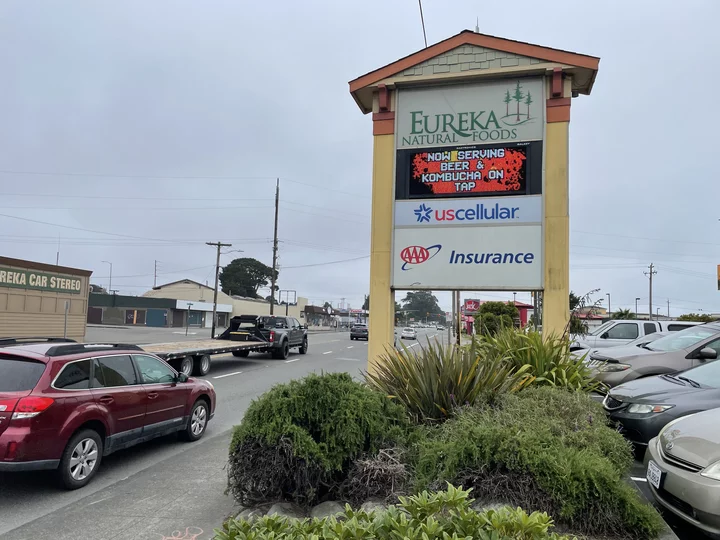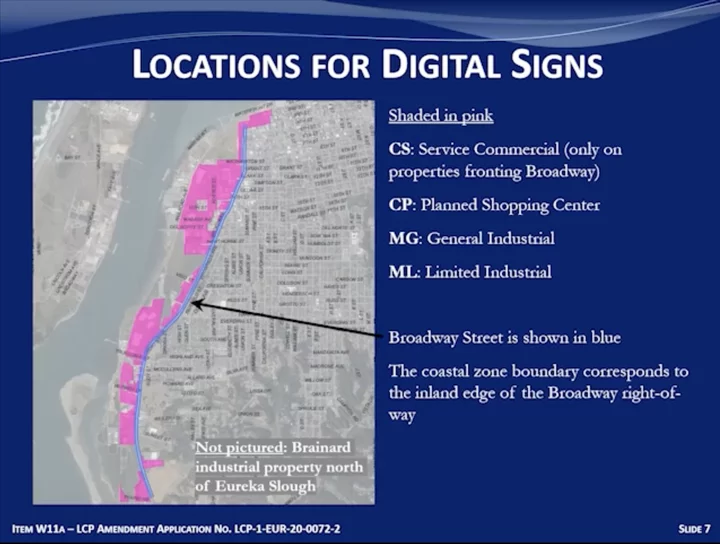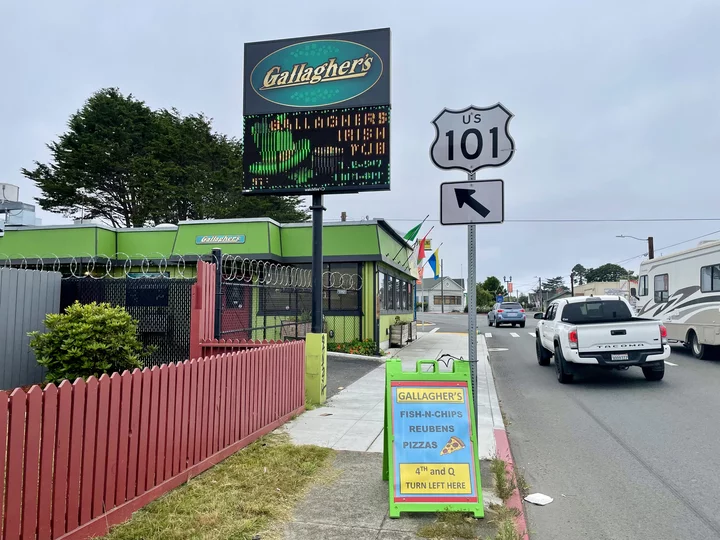
Digital signs like this one at Eureka Natural Foods will still comply with all applicable regulations, but simpler “sign-on-a-stick” designs for digital signs will no longer be allowed in the city’s coastal zone. | Photos by Ryan Burns.
###
A pair of rulings from last week’s meeting of the California Coastal Commission will reduce the number of illuminated digital signs allowed in Eureka’s coastal zone while also limiting how bright they can be.
Once the new rules are adopted by the city, which is scheduled to happen this fall, Eureka businesses that still want to erect digital billboards in the coastal zone will have to submit their plans to the city’s design review committee for approval at a public hearing.
Coastal commissioners, including Humboldt County Supervisor Mike Wilson, said these new restrictions will help to limit encroaching light pollution, and they urged city officials to go even farther to slow the spread of these bright, frequently animated digital advertisements.
Eureka’s planning staff has spent years working to update the city’s Local Coastal Program (LCP), a planning tool used to guide development in the coastal zone. At last week’s meeting, held in Fort Bragg, the City was asking the Coastal Commission to approve an amendment to the sign-related portions of its LCP.
In a staff presentation, Coastal Commission North Coast District Manager Melissa B. Kramer noted that the current version of Eureka’s program doesn’t include any standards for digital sign design, which can be a problem.
“Digital signs raise visual issues because they can be distracting and visually incompatible with the scenic nature of waterfront areas and other scenic coastal areas,” Kramer said.
The city’s new design standards would require the digital component — that bright, illuminated screen — to be integrated into another type of sign and include “a substantial non-digital component of the same material, form and color of the rest of the sign.” (The one outside Eureka Natural Foods, pictured above, would comply with those standards.) Furthermore, the message on the digital display may not change more frequently than once every 15 seconds under the new rules.

Slide from Coastal Commission staff presentation.
###
Eureka’s coastal zone covers the land west of Broadway as well as portions of Old Town and downtown north of Third Street. Eureka staff originally wanted to limit digital signs to the pink-colored parcels shown in the map above, but at the recommendation of Coastal Commission staff, new digital signs will also be prohibited on coastal zone parcels zoned industrial.
In a phone interview, Kristen Goetz, principal planner for the City of Eureka, said there are 139 such parcels in the city’s coastal zone. Signs will still be allowed on the 71 parcels zoned service commercial (CS) in the coastal zone. To date, Goetz said, seven digital signs have been erected in the city’s coastal zone, and they will be allowed to remain standing, even if the Eureka City Council adopts the new rules.
(If they happen to get knocked down, however — say, by a natural disaster or speeding car — then the owners likely wouldn’t be allowed to rebuild the signs unless they comply with the new rules.)
During the public comment period, Humboldt Baykeeper Executive Director Jennifer Kalt urged the commission to prohibit these signs throughout Eureka’s coastal zone “to protect wildlife from night glare and protect public safety from distracted drivers on a very dangerous stretch of highway.”
She noted that digital signs, which contain thousands of LED lights, can be up to 10 times brighter than standard illuminated signs, contributing to light pollution and potentially affecting nocturnal wildlife’s eating, foraging and orientation behaviors.
Kalt urged the commission to follow the guidelines of the International Dark-Sky Association, which works to reduce light pollution and offers program guidelines for local governments.
Wilson said he’s worried about the proliferation of digital signs along Broadway, and he noted that the light pollution can be worse when the sky is overcast because the lights reflect off the cloud cover. He asked Goetz, who was in attendance at last week’s meeting, whether city staff had looked into the International Dark-Sky Association’s guidelines.
“Currently, our code in the coastal zone that regulates signs is from about 1966 … ,” she said. “So no, it does not have any limitations or probably didn’t even conceive of the fact that there could ever be a digital sign.”
Goetz said she doesn’t believe city officials would object to incorporating the International Dark-Sky Association’s guidelines in the coastal zone.
Wilson asked Goetz whether city officials would also be amenable to requiring a discretionary permit for such signs, and she said she believes so.
Fellow commissioner Linda Escalante, who described herself as both a climate change refugee and light pollution refugee, said that when she drives up California’s coastal highways from Los Angeles she notices a dramatic change.
“There’s just something when you drive up here and start seeing clear skies, I don’t know — it kind of reinforces our humanity and our connection to the universe,” she said. “So I hope that the North Coast tries its hardest to avoid turning into Atlantic City or L.A. or something like that. … I do hope that [Eureka officials] reevaluate how important it is to save some of that precious night sky in this particular region.”
Goetz told the Outpost that such decisions will rest with the City Council. She still needs to bring this Coastal Commission-approved ordinance to the council — hopefully introducing it at the August 16 meeting, which would allow it to be adopted at the September 20 meeting.
She said she’ll tell the council that the Coastal Commission urged them not to allow any more digital signs. Whether they choose to do so will be up to them.

A digital sign outside Gallagher’s, on Fourth Street.
CLICK TO MANAGE